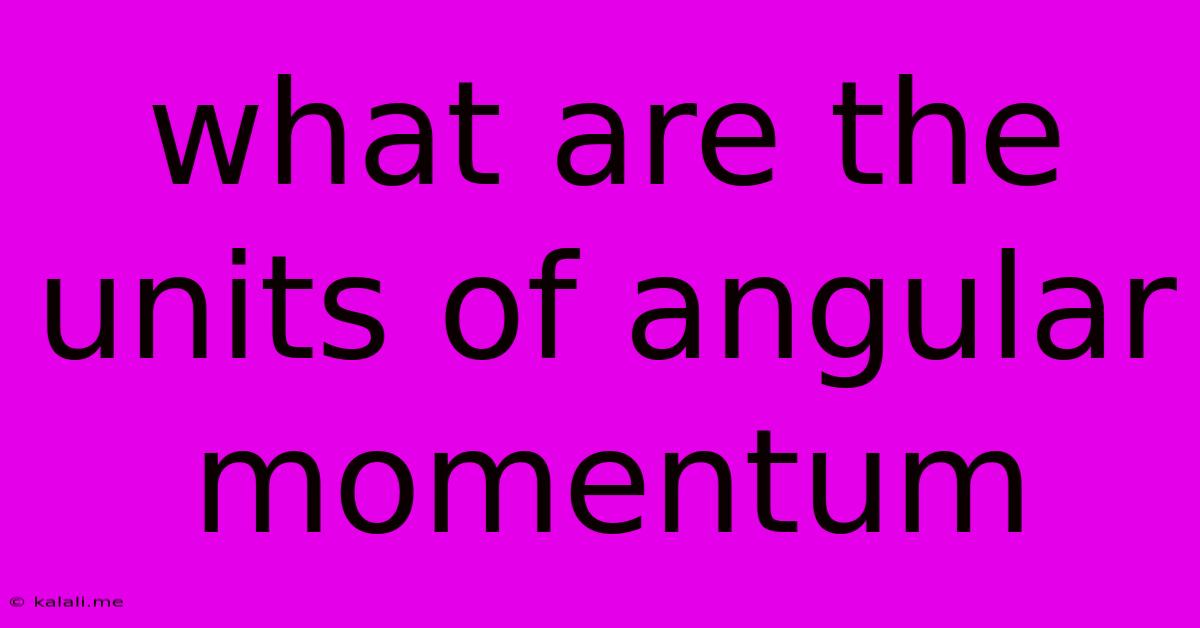What Are The Units Of Angular Momentum
Kalali
Jun 15, 2025 · 3 min read

Table of Contents
What are the Units of Angular Momentum? A Comprehensive Guide
Angular momentum, a crucial concept in physics, describes the rotational equivalent of linear momentum. Understanding its units is essential for anyone working with rotational motion, from classical mechanics to quantum physics. This article will delve into the units of angular momentum, exploring their derivation and practical applications.
What is Angular Momentum? Before diving into the units, let's briefly revisit the concept itself. Angular momentum (often denoted as 'L') represents the tendency of a rotating object to continue rotating. It's a vector quantity, meaning it has both magnitude and direction. The direction of the angular momentum vector is determined by the right-hand rule.
Derivation of the Units of Angular Momentum
The formula for angular momentum is:
L = Iω
where:
- L represents angular momentum
- I represents the moment of inertia (a measure of an object's resistance to changes in its rotation)
- ω represents angular velocity (the rate of change of angular displacement)
Let's break down the units of each component:
-
Moment of Inertia (I): The units of moment of inertia are kilogram-meter squared (kg⋅m²). This arises from its definition, which involves the mass of the object and the square of its distance from the axis of rotation.
-
Angular Velocity (ω): The units of angular velocity are radians per second (rad/s). Radians are dimensionless, representing the ratio of arc length to radius.
Therefore, the units of angular momentum (L) are the product of the units of moment of inertia and angular velocity:
kg⋅m² × rad/s = kg⋅m²/s
Since radians are dimensionless, they can be omitted, leaving us with the simplified unit: kilogram-meter squared per second (kg⋅m²/s). This is the standard unit for angular momentum in the International System of Units (SI).
Understanding the Units in Different Contexts
The kg⋅m²/s unit provides a clear representation of angular momentum's physical meaning. It combines mass (kg), distance (m²), and time (s), reflecting the rotational inertia and speed of the rotating object.
-
Classical Mechanics: In classical mechanics, this unit is universally used to quantify the angular momentum of macroscopic objects like spinning tops, planets orbiting stars, or rotating wheels.
-
Quantum Mechanics: While the SI unit remains applicable, quantum mechanics introduces a different perspective. Angular momentum is quantized, meaning it only exists in discrete values, multiples of the reduced Planck constant (ħ = h/2π, where h is Planck's constant). Though the underlying unit remains kg⋅m²/s, the quantized nature adds another layer of complexity.
Other Relevant Quantities and Units:
Understanding angular momentum often involves interacting with related quantities:
- Torque (τ): The rate of change of angular momentum. Its unit is the newton-meter (N⋅m).
- Angular Acceleration (α): The rate of change of angular velocity. Its unit is radians per second squared (rad/s²).
Conclusion:
The units of angular momentum, kg⋅m²/s, are fundamental to understanding and calculating this essential physical quantity. Whether you're analyzing the spin of an electron or the rotation of a galaxy, grasping these units is crucial for a complete comprehension of rotational motion and its implications across various branches of physics. Remember the derivation from the moment of inertia and angular velocity helps solidify your understanding of this fundamental concept.
Latest Posts
Latest Posts
-
80 Of X Is Equal To 100
Jun 15, 2025
-
What Are The First Five Multiples Of 5
Jun 15, 2025
-
What Is The Coefficient Of Discharge
Jun 15, 2025
-
Consider Steady State Conditions For One Dimensional Conduction
Jun 15, 2025
-
Difference Between High Pass And Low Pass Filter
Jun 15, 2025
Related Post
Thank you for visiting our website which covers about What Are The Units Of Angular Momentum . We hope the information provided has been useful to you. Feel free to contact us if you have any questions or need further assistance. See you next time and don't miss to bookmark.